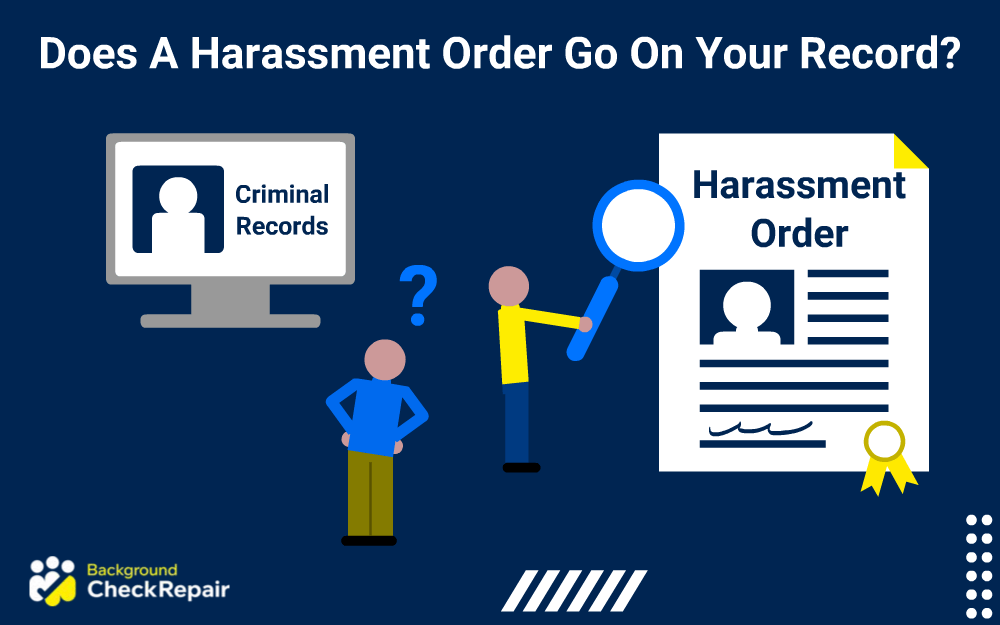Does An Order Of Protection Go On Your Record?
Yes, orders of protection are public information and will show up on an individual’s record.
 Written by Background Check Repair
Written by Background Check Repair
Criminal Records | June 17, 2024

Table of Contents
Although it can happen without official charges being filed, many individuals wonder, does a harassment order go on your record? The answer is both yes…and no.
Because harassment orders are very similar to protection orders (which can proceed with a restraining order, or be extended as a type of restraining order) they are typically considered public records. In other words, this sort of court-ordered document will usually show up on a level 2 criminal background check. This leads many people to wonder whether employment may be revoked due to background checks. And it’s a legitimate concern, especially if the harassment order is (or was) work related.
Since many states have passed legislation that ensures anyone can look up protection orders, like a sex offender registry (which is designed to prevent crime by making people aware of potentially violent individuals), it’s important to understand the differences between these types of criminal records (like what disqualifies you from a level 2 background check) and how to search for them using official records.
However, accessing ‘protection orders’ is a bit different in every state and some states utilize different terms to explain the same thing, so how can it be done? The following guide provides all the information needed to answer “does a harassment order go on your record,” and delivers step-by-step instructions on how to search these types of orders in any state.
Keep in mind, if the harassment order was “sealed” or “expunged” through court processes, then it is erased from the record. Only certain law agencies will even be able to find it.
Basically, if a civil order is issued for harassment or protection, this will NOT go on a criminal record. It will only appear on someone’s criminal record if that person violates the order.
A criminal protection order, or a criminal harassment order will show up on a background check as part of the criminal record.
Harassment order, restraining order, and order of protection are terms that are all used interchangeably at times, and different states have different meanings for each.
Although they are all quite similar there are important legal distinctions that separate one from the other, depending on the state where the order occurred. But the end result of all of these is the same, one individual is not allowed to go near another individual, business, piece of property, etc.

The real distinction lies in the time frame relative to the order and whether the order stems from a civil or criminal incident. For example, in some states, protection orders are issued quickly, designed to ensure someone’s safety, and they act as temporary restraining orders. Then, after a hearing, these orders will be transformed into a more lasting restraining order or occasionally dropped for lack of evidence.
Legally speaking, the main difference between a restraining order and an order of protection is why they are filed. A restraining order is usually the result of a civil case and granted on a temporary basis. One individual will need probable cause to file a restraining order to protect themselves from abuse, violence, threats or other potential harm. This will be filed by an individual and then a judge will decide if the individual is in imminent danger to decide if the restraining order should be granted.
Remember that all states have their own terminology and processes (outlined below), but anyone can find out what shows up on fingerprint background check reports by contacting their state police department.
On the other hand, an order of protection is usually the result of a criminal case. For example in a domestic abuse case, a judge may decide to file an order of protection in order to protect the alleged victim from their abuser. This will also extend to any witnesses and forbids the individual from having any contact with the defendant.

Although the end result is the same, an order of protection usually lasts the duration of the criminal case, whereas a restraining order will last up to 14 days after first being filed. During this 14-day period, there will be a hearing in front of a judge to decide whether or not the temporary restraining order will become a permanent restraining order.
Also, remember that laws can change frequently, like California background check laws, 2022 saw changes that impact what potential employers can see.
Individuals who have had a restraining order filed against them will likely wonder “does a harassment order go on your record?” Unless the court documents have been sealed for some reason, all restraining orders are considered public information. Since searching public records is how background checks work, restraining orders will likely show up on the record.
Searching state court records (similar to the way for finding old arrest records) is a relatively easy and straightforward process. Since virtually every state has an online case search system for state court cases, the process can usually be completed in a few minutes.
Individuals asking Does a harassment order go on your record will also be wondering how to find harassment order records. Luckily, this can be done fairly easily with the use of state court case search tools. This is also the method that can be used for how to find out if someone has a felony for free, since most searches are free to access, but a report will cost a small amount.
Step 1: Access the State Court website
The first thing to do is access the official state courts website for your specific state. This will have information about how to search the state court case search.
For example, the Montana judicial branch website has a link to search Montana Supreme Court dockets by name or case number.
Step 2: Perform Search
Once the case search tool has been located, simply follow each state’s unique step to perform a search. The case number is usually the best way to perform the search but using the first and last name of an individual should also work.
Keep in mind that some states may require users to create an account and or pay a small fee to perform searches and obtain results.
Each state has its own unique laws and rules regarding orders of protection. This includes when they can be filed, what they permit the individual to do and not do, as well as how long they can be enforced before the order of protection is dropped or renewed.
For example, anyone can fill out a petition to have protection, harassment or restraining order filed. In general, most states grant these temporary orders without much delay.
However, the temporary order must be examined by a court to be changed into a lasting or permanent one.
A state’s legal code contains information on the specific regulations regarding the order of protection laws, which can often be found on the state judiciary website.
| State Order of Protection | Legal Code |
| Order of Protection Rules AL | 30-5-1 |
| Order of Protection Rules AK | 18.66 |
| Order of Protection Rules AZ | 13-3602 |
| Order of Protection Rules CA | 273.6 |
| Order of Protection Rules CO | 13-14-105(1) |
| Order of Protection Rules CT | CGS 46b – 16a |
| Order of Protection Rules DE | Tit. 10 1041 |
| Order of Protection Rules FL | 741.30 |
| Order of Protection Rules GA | 15 – 11 – 29 |
| Order of Protection Rules HI | 586 – 11 |
| Order of Protection Rules ID | 18 – 7907 |
| Order of Protection Rules IL | 750 ILCS 60/214(a) |
| Order of Protection Rules IN | 34-26-5-3(e)(2) |
| Order of Protection Rules IA | 664A.3 |
| Order of Protection Rules KS | 60-31a06 |
| Order of Protection Rules KY | 18 U.S.C. Section 922(g)(8)) |
| Order of Protection Rules LA | 14:79 |
| Order of Protection Rules ME | Title 17- A 506-B |
| Order of Protection Rules MD | Rule 2-403 |
| Order of Protection Rules MA | Chapter 208 Section 34C |
| Order of Protection Rules MI | 600.2950 |
| Order of Protection Rules MN | 518B.01 |
| Order of Protection Rules MO | 455.035 |
| Order of Protection Rules MS | 93-21-15 |
| Order of Protection Rules MT | 40-15-201 |
| Order of Protection Rules NE | 49-924 |
| Order of Protection Rules NV | 33.017 |
| Order of Protection Rules NH | 173-B |
| Order of Protection Rules NJ | Section C 2C:14-16 |
| Order of Protection Rules NM | 40-13-6 |
| Order of Protection Rules NY | 530.13 |
| Order of Protection Rules NC | Chapter 50B |
| Order of Protection Rules ND | t14c07.1 |
| Order of Protection Rules OH | 2919.27 |
| Order of Protection Rules OK | 22-60.4 |
| Order of Protection Rules OR | 107.700 |
| Order of Protection Rules PA | Chapter 61 Title 23 |
| Order of Protection Rules RI | 15-15-3 |
| Order of Protection Rules SC | 20-4-60 |
| Order of Protection Rules SD | 25-10-1 |
| Order of Protection Rules TN | 22535 Order of Protection Benchmark |
| Order of Protection Rules TX | 25.07.4.1 |
| Order of Protection Rules UT | 78B-7-1 |
| Order of Protection Rules VT | 1101(2) |
| Order of Protection Rules VI | 19.2-152.10 |
| Order of Protection Rules WA | RCW 26.50.030 |
| Order of Protection Rules WV | 48-5-509(B) |
| Order of Protection Rules WI | 813.125 |
| Order of Protection Rules WY | 35-21-108 |
In most states, a harassment charge will stay on your record indefinitely. Just like any other criminal record, most states do not have any laws regarding how long it can show up on a record.

There are several states that are referred to as “seven-year states,” which only allow background checks to show criminal history information going back 7-10 years.
In short, harassment charges will stay on your record for as long as state law allows, which in most cases is an indefinite amount of time, especially if the order is connected to a recent arrest. Want to know how to locate recent arrests? Use the same steps outlined above, or follow the steps for finding out do police reports go on your record.
Harassment orders and restraining order violations are very serious matters.
Those wondering “does a harassment order go on your record?” should know by now that the answer is yes, and the same is true for violations of the order. In general, what happens will depend on state law and the manner in which the restraining order was broken.
In most cases, this will be a misdemeanor at the very least, which can be punishable by jail time. More serious violations may result in felony charges.
Restraining orders are a serious matter. Individuals who find themselves on either side of a restraining order should contact an attorney. An attorney will be able to provide a more details about “Does a harassment order go on your record,” with an answer that is specific to local laws and the unique circumstances of the case.
Yes, orders of protection are public information and will show up on an individual’s record.
How long a harassment charge stays on your record will depend on state laws regarding criminal records. Most states allow harassment charges to stay on your record forever.
Yes, Harassment charges will go on your record and show up on a criminal background check.
Restraining orders will go on your record in most cases. If for some reason the record is sealed it will not appear, but this is extremely rare.
A restraining order will stay on your record forever in most states. Some states have laws determining how long criminal records can appear on records, but most allow them to be on record forever.
The exact proof will largely depend on the specific circumstances of the case, however, being able to prove that an individual poses an imminent threat to your health or safety is usually all that is required. Individuals considering filing a restraining order should contact an attorney.
Yes, harassment orders will go on your record the same as any other criminal history information would.
Many people with a harassment order wonder if charges are dismissed, do you have a criminal record? The answer varies. If the dismissed charges were expunged or sealed, then likely no, the record is clear. However, even dismissed charges can show up on a background check if not expunged.
Unfortunately, charges that have been dismissed remain a part of public records in most cases. However, this depends on the original infraction as well as where it happened (which state and local jurisdiction).
We use cookies to ensure that we give you the best experience on our website. If you continue to use this site we will assume that you are happy with it